NISSAN JUKE 2017 F15 / 1.G Owners Manual
Manufacturer: NISSAN, Model Year: 2017, Model line: JUKE, Model: NISSAN JUKE 2017 F15 / 1.GPages: 416, PDF Size: 2.62 MB
Page 401 of 416

10-16Technical and consumer information
STI0447
Steps for determining correct load limit
1.Locate the statement “The combined
weight of occupants and cargo
should never exceed XXX kg or XXX
lbs” on your vehicle’s placard.
2.Determine the combined weight of
the driver and passengers that will be
riding in your vehicle.
3.Subtract the combined weight of the
driver and passengers from XXX kg
or XXX lbs.
4.The resulting figure equals the avail-
able amount of cargo and luggage
load capacity. For example, if the XXX
amount equals 1400 lbs. and there
will be five 150 lb. passengers in your
vehicle, the amount of available cargo
and luggage load capacity is 650 lbs.
(1400�í750 (5 x 150) = 650 lbs) or
(640 �í340 (5 x 70) = 300 kg.)
5.Determine the combined weight of
luggage and cargo being loaded on
the vehicle. That weight may not
safely exceed the available cargo
and luggage load capacity calculated
in Step 4.
Before driving a loaded vehicle, confirm
that you do not exceed the Gross Vehicle
Weight Rating (GVWR) or the Gross
Axle Weight Rating (GAWR) for your
vehicle. (See “Measurement of weights”
(P.10-17) .)
Also check tires for proper inflation
pressures. See the Tire and Loading
Information label.
Page 402 of 416
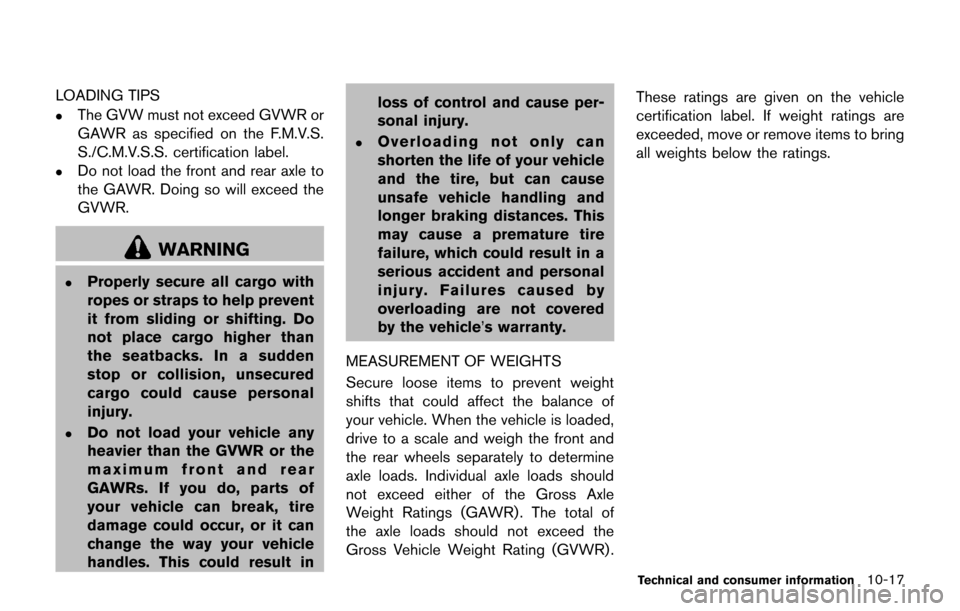
LOADING TIPS
.The GVW must not exceed GVWR or
GAWR as specified on the F.M.V.S.
S./C.M.V.S.S. certification label.
.Do not load the front and rear axle to
the GAWR. Doing so will exceed the
GVWR.
WARNING
.Properly secure all cargo with
ropes or straps to help prevent
it from sliding or shifting. Do
not place cargo higher than
the seatbacks. In a sudden
stop or collision, unsecured
cargo could cause personal
injury.
.Do not load your vehicle any
heavier than the GVWR or the
maximum front and rear
GAWRs. If you do, parts of
your vehicle can break, tire
damage could occur, or it can
change the way your vehicle
handles. This could result inloss of control and cause per-
sonal injury.
.Overloading not only can
shorten the life of your vehicle
and the tire, but can cause
unsafe vehicle handling and
longer braking distances. This
may cause a premature tire
failure, which could result in a
serious accident and personal
injury. Failures caused by
overloading are not covered
by the vehicle’s warranty.
MEASUREMENT OF WEIGHTS
Secure loose items to prevent weight
shifts that could affect the balance of
your vehicle. When the vehicle is loaded,
drive to a scale and weigh the front and
the rear wheels separately to determine
axle loads. Individual axle loads should
not exceed either of the Gross Axle
Weight Ratings (GAWR) . The total of
the axle loads should not exceed the
Gross Vehicle Weight Rating (GVWR) . These ratings are given on the vehicle
certification label. If weight ratings are
exceeded, move or remove items to bring
all weights below the ratings.
Technical and consumer information10-17
Page 403 of 416
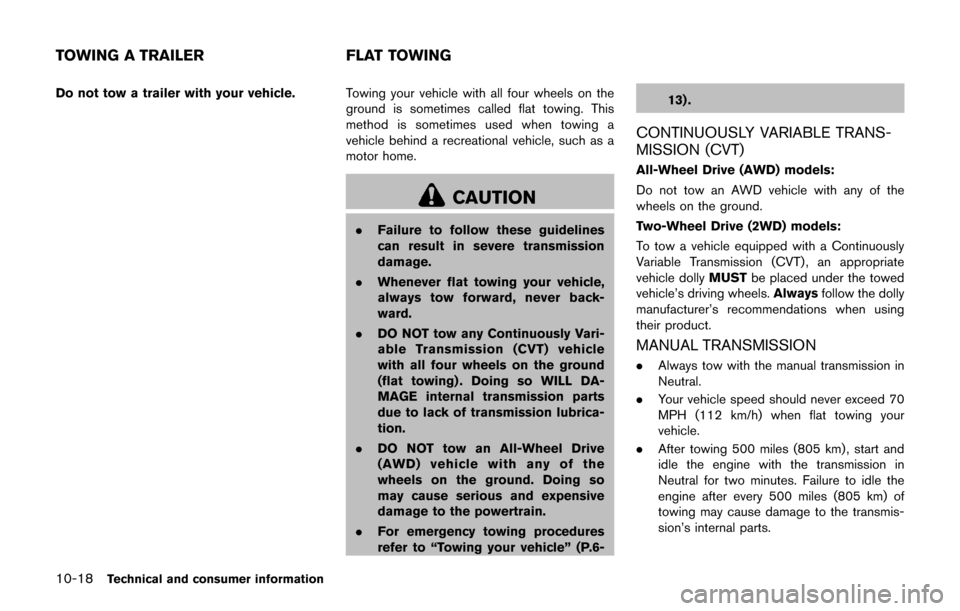
10-18Technical and consumer information
Do not tow a trailer with your vehicle.Towing your vehicle with all four wheels on the
ground is sometimes called flat towing. This
method is sometimes used when towing a
vehicle behind a recreational vehicle, such as a
motor home.
CAUTION
.Failure to follow these guidelines
can result in severe transmission
damage.
. Whenever flat towing your vehicle,
always tow forward, never back-
ward.
. DO NOT tow any Continuously Vari-
able Transmission (CVT) vehicle
with all four wheels on the ground
(flat towing) . Doing so WILL DA-
MAGE internal transmission parts
due to lack of transmission lubrica-
tion.
. DO NOT tow an All-Wheel Drive
(AWD) vehicle with any of the
wheels on the ground. Doing so
may cause serious and expensive
damage to the powertrain.
. For emergency towing procedures
refer to “Towing your vehicle” (P.6- 13) .
CONTINUOUSLY VARIABLE TRANS-
MISSION (CVT)
All-Wheel Drive (AWD) models:
Do not tow an AWD vehicle with any of the
wheels on the ground.
Two-Wheel Drive (2WD) models:
To tow a vehicle equipped with a Continuously
Variable Transmission (CVT) , an appropriate
vehicle dolly
MUSTbe placed under the towed
vehicle’s driving wheels. Alwaysfollow the dolly
manufacturer’s recommendations when using
their product.
MANUAL TRANSMISSION
. Always tow with the manual transmission in
Neutral.
. Your vehicle speed should never exceed 70
MPH (112 km/h) when flat towing your
vehicle.
. After towing 500 miles (805 km) , start and
idle the engine with the transmission in
Neutral for two minutes. Failure to idle the
engine after every 500 miles (805 km) of
towing may cause damage to the transmis-
sion’s internal parts.
TOWING A TRAILER FLAT TOWING
Page 404 of 416
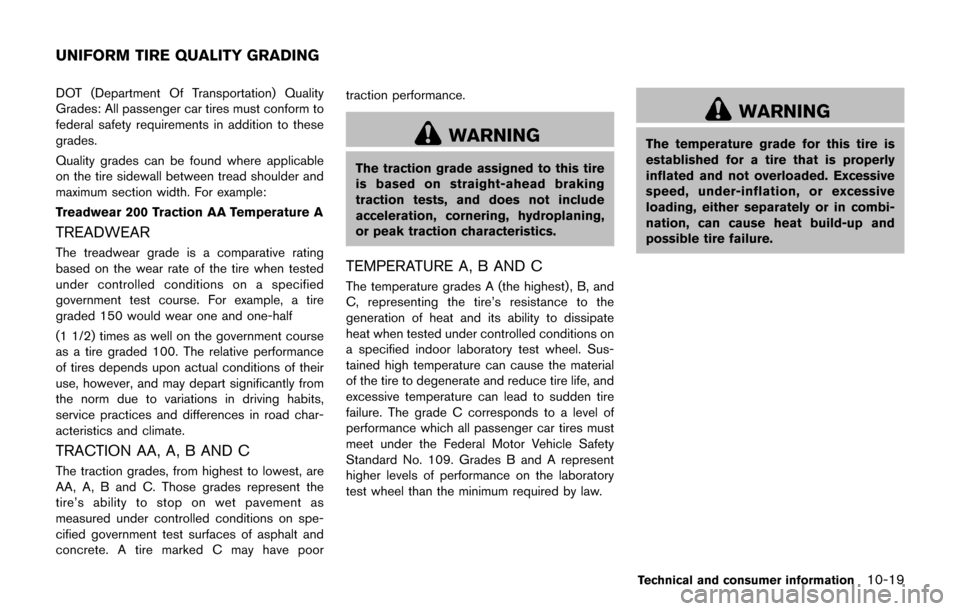
DOT (Department Of Transportation) Quality
Grades: All passenger car tires must conform to
federal safety requirements in addition to these
grades.
Quality grades can be found where applicable
on the tire sidewall between tread shoulder and
maximum section width. For example:
Treadwear 200 Traction AA Temperature A
TREADWEAR
The treadwear grade is a comparative rating
based on the wear rate of the tire when tested
under controlled conditions on a specified
government test course. For example, a tire
graded 150 would wear one and one-half
(1 1/2) times as well on the government course
as a tire graded 100. The relative performance
of tires depends upon actual conditions of their
use, however, and may depart significantly from
the norm due to variations in driving habits,
service practices and differences in road char-
acteristics and climate.
TRACTION AA, A, B AND C
The traction grades, from highest to lowest, are
AA, A, B and C. Those grades represent the
tire’s ability to stop on wet pavement as
measured under controlled conditions on spe-
cified government test surfaces of asphalt and
concrete. A tire marked C may have poortraction performance.
WARNING
The traction grade assigned to this tire
is based on straight-ahead braking
traction tests, and does not include
acceleration, cornering, hydroplaning,
or peak traction characteristics.
TEMPERATURE A, B AND C
The temperature grades A (the highest) , B, and
C, representing the tire’s resistance to the
generation of heat and its ability to dissipate
heat when tested under controlled conditions on
a specified indoor laboratory test wheel. Sus-
tained high temperature can cause the material
of the tire to degenerate and reduce tire life, and
excessive temperature can lead to sudden tire
failure. The grade C corresponds to a level of
performance which all passenger car tires must
meet under the Federal Motor Vehicle Safety
Standard No. 109. Grades B and A represent
higher levels of performance on the laboratory
test wheel than the minimum required by law.
WARNING
The temperature grade for this tire is
established for a tire that is properly
inflated and not overloaded. Excessive
speed, under-inflation, or excessive
loading, either separately or in combi-
nation, can cause heat build-up and
possible tire failure.
Technical and consumer information10-19
UNIFORM TIRE QUALITY GRADING
Page 405 of 416

10-20Technical and consumer information
Your vehicle is covered by the following emis-
sion warranties.
For USA:
.Emission Defects Warranty
. Emissions Performance Warranty
Details of these warranties may be found with
other vehicle warranties in your Warranty In-
formation Booklet which comes with your
vehicle. If you did not receive a Warranty
Information Booklet, or it has become lost, you
may obtain a replacement by writing to:
. Nissan North America, Inc.
Consumer Affairs Department
P.O. Box 685003
Franklin, TN 37068-5003
For Canada:
Emission Control System Warranty
Details of this warranty may be found with other
vehicle warranties in your Warranty Information
Booklet which comes with your vehicle. If you
did not receive a Warranty Information Booklet,
or it has become lost, you may obtain a
replacement by writing to:
. Nissan Canada Inc.
5290 Orbitor Drive
Mississauga, Ontario,
L4W 4Z5For USA
If you believe that your vehicle has a
defect which could cause a crash or
could cause injury or death, you should
immediately inform the National Highway
Traffic Safety Administration (NHTSA) in
addition to notifying NISSAN.
If NHTSA receives similar complaints, it
may open an investigation, and if it finds
that a safety defect exists in a group of
vehicles, it may order a recall and remedy
campaign. However, NHTSA cannot
become involved in individual problems
between you, your dealer, or NISSAN.
To contact NHTSA, you may call the
Vehicle Safety Hotline toll-free at 1-888-
327-4236 (TTY: 1-800-424-9153); go
to http://www.safercar.gov; or write to:
Administrator, NHTSA, 400 Seventh
Street, SW., Washington, D.C. 20590.
You can also obtain other information
about motor vehicle safety from http://
www.safercar.gov.
You may notify NISSAN by contacting
our Consumer Affairs Department, toll- free, at 1-800-NISSAN-1.
For Canada
If you believe that your vehicle has a
defect which could cause a crash or
could cause injury or death, you should
immediately inform Transport Canada in
addition to notifying NISSAN.
If Transport Canada receives complaints,
it may open an investigation, and if it
finds that a safety defect exists in a group
of vehicles, it may request that NISSAN
conduct a recall campaign. However,
Transport Canada cannot become in-
volved in individual problems between
you, your dealer, or NISSAN.
You may contact Transport Canada’s
Defect Investigations and Recalls Divi-
sion toll free at 1-800-333-0510. You
may also report safety defects online at:
https://wwwapps.tc.gc.ca/Saf-Sec-Sur/
7/ PCDB-BDPP/Index.aspx.
Additional information concerning motor
vehicle safety may be obtained from
Transport Canada’s Road Safety Infor-
EMISSION CONTROL SYSTEM
WARRANTY
REPORTING SAFETY DEFECTS
Page 406 of 416
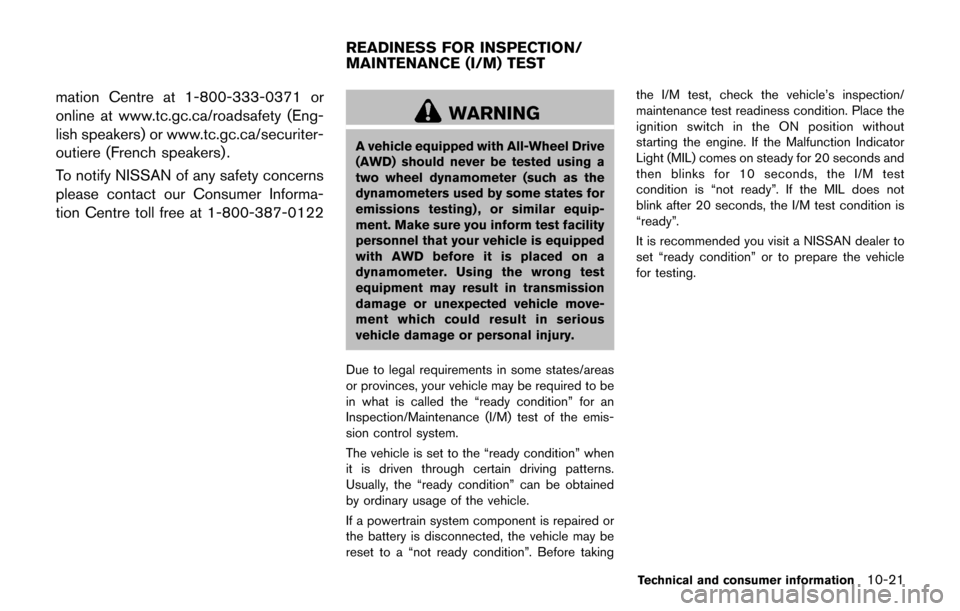
mation Centre at 1-800-333-0371 or
online at www.tc.gc.ca/roadsafety (Eng-
lish speakers) or www.tc.gc.ca/securiter-
outiere (French speakers) .
To notify NISSAN of any safety concerns
please contact our Consumer Informa-
tion Centre toll free at 1-800-387-0122
WARNING
A vehicle equipped with All-Wheel Drive
(AWD) should never be tested using a
two wheel dynamometer (such as the
dynamometers used by some states for
emissions testing) , or similar equip-
ment. Make sure you inform test facility
personnel that your vehicle is equipped
with AWD before it is placed on a
dynamometer. Using the wrong test
equipment may result in transmission
damage or unexpected vehicle move-
ment which could result in serious
vehicle damage or personal injury.
Due to legal requirements in some states/areas
or provinces, your vehicle may be required to be
in what is called the “ready condition” for an
Inspection/Maintenance (I/M) test of the emis-
sion control system.
The vehicle is set to the “ready condition” when
it is driven through certain driving patterns.
Usually, the “ready condition” can be obtained
by ordinary usage of the vehicle.
If a powertrain system component is repaired or
the battery is disconnected, the vehicle may be
reset to a “not ready condition”. Before taking the I/M test, check the vehicle’s inspection/
maintenance test readiness condition. Place the
ignition switch in the ON position without
starting the engine. If the Malfunction Indicator
Light (MIL) comes on steady for 20 seconds and
then blinks for 10 seconds, the I/M test
condition is “not ready”. If the MIL does not
blink after 20 seconds, the I/M test condition is
“ready”.
It is recommended you visit a NISSAN dealer to
set “ready condition” or to prepare the vehicle
for testing.
Technical and consumer information10-21
READINESS FOR INSPECTION/
MAINTENANCE (I/M) TEST
Page 407 of 416

10-22Technical and consumer information
This vehicle is equipped with an Event Data
Recorder (EDR) . The main purpose of an EDR is
to record, in certain crash or near crash-like
situations, such as an air bag deployment or
hitting a road obstacle, data that will assist in
understanding how a vehicle’s systems per-
formed. The EDR is designed to record data
related to vehicle dynamics and safety systems
for a short period of time, typically 30 seconds
or less. The EDR in this vehicle is designed to
record such data as:
.How various systems in your vehicle were
operating;
. Whether or not the driver and passenger
safety belts were buckled/fastened;
. How far (if at all) the driver was depressing
the accelerator and/or brake pedal; and,
. How fast the vehicle was traveling.
. Sounds are not recorded.
These data can help provide a better under-
standing of the circumstances in which crashes
and injuries occur.
NOTE: EDR data are recorded by your vehicle
only if a nontrivial crash situation occurs; no data
are recorded by the EDR under normal driving
conditions and no personal data (e.g. name,
gender, age and crash location) are recorded.
However, other parties, such as law enforce-
ment, could combine the EDR data with the type of personally identifying data routinely acquired
during a crash investigation.
To read data recorded by an EDR, special
equipment is required and access to the vehicle
or the EDR is needed. In addition to the vehicle
manufacturer and NISSAN dealer, other parties,
such as law enforcement, that have the special
equipment, can read the information if they have
access to the vehicle or the EDR. EDR data will
only be accessed with the consent of the vehicle
owner or lessee or as otherwise required or
permitted by law.
Genuine NISSAN Service Manuals for this
model year and prior can be purchased. A
genuine NISSAN Service Manual is the best
source of service and repair information for your
vehicle. This manual is the same one used by the
factory trained technicians working at a NISSAN
dealer. Genuine NISSAN Owner’s Manuals can
also be purchased.
In the USA:
For current pricing and availability of genuine
NISSAN Service Manuals
contact:
www.nissan-techinfo.com
For current pricing and availability of genuine
NISSAN Owner’s Manuals contact:
1-800-247-5321
In Canada:
To purchase a copy of a genuine NISSAN
Service Manual or Owner’s Manual for this
model year and prior please contact a NISSAN
dealer. For the phone number and location of a
NISSAN dealer in your area call the NISSAN
Information Center at 1-800-387-0122 and a
bilingual NISSAN representative will assist you.
EVENT DATA RECORDERS (EDR) OWNER’S MANUAL/SERVICE
MANUAL ORDER INFORMATION
Page 408 of 416

11 Index
A
ABS (Anti-lock Braking System) ............................ 5-36
Adjusting the screen .................................................. 4-11
Advanced air bag system ......................................... 1-44
Air bag systemAdvanced air bag system .................................. 1-44
Front passenger air bag and status light ...... 1-46
Front-seat mounted side-impact
supplemental air bag system ............................ 1-51
Roof-mounted curtain side-impact
supplemental air bag system ............................ 1-51
Air bag warning labels .............................................. 1-54
Air bag warning light ..................................... 1-54, 2-20
Air cleaner housing filter ........................................... 8-14
Air conditioner Air conditioner operation ................................... 4-28
Air conditioner service ....................................... 4-35
Air conditioner specification label ................. 10-13
Air conditioning system refrigerant and
lubricant recommendations .................... 4-35, 10-8
In-cabin microfilter ............................................... 4-35
Air conditioner operation .......................................... 4-31
Alarm, How to stop alarm (see vehicle
security system) .......................................................... 2-34
Alcohol, drugs and driving ......................................... 5-7
All-wheel drive (AWD) .............................................. 5-29
Antenna ......................................................................... 4-75
Anti-lock Braking System (ABS) ............................ 5-36
Anti-lock braking system (ABS) warning light .... 2-16
Appearance care Exterior appearance care ..................................... 7-2
Interior appearance care ....................................... 7-5
Application download ................................................ 4-76
Around View
�ŠMonitor .............................................. 4-13 Audible reminders ...................................................... 2-23
Audio operation precautions ................................... 4-35
Audio system ............................................................... 4-35
Steering wheel audio controls ......................... 4-73
Autolight system ......................................................... 2-40
Automatic Air conditioner ...................................................... 4-32
Door locks ................................................................ 3-5
Average fuel consumption ........................................ 2-13
Avoiding collision and rollover .................................. 5-6
B
Back door (See liftgate) ........................................... 3-16
Battery ........................................................................... 8-10 Battery replacement, Intelligent Key ............... 8-20
Battery saver system .......................................... 2-41
Variable voltage control system ....................... 8-12
Before starting the engine ....................................... 5-12
Bluetooth
�ŠHands-Free Phone System .... 4-80, 4-89
Bluetooth�Šsettings ........................................ 4-88, 4-94
Bluetooth�Šstreaming audio ......................... 4-60, 4-71
Booster seats .............................................................. 1-34
Brake Anti-lock Braking System (ABS) ..................... 5-36
Brake and clutch fluid ........................................... 8-9
Brake system ........................................................ 5-35
Parking brake operation ..................................... 5-25
Warning light ........................................................ 2-16
Break-in schedule ....................................................... 5-27
Brightness control Instrument panel .................................................. 2-43
Bulb check/instrument panel ................................... 2-16
Bulb replacement ....................................................... 8-23
C
Cabin air filter .............................................................. 4-35
Capacities and
recommended fluids/lubricants ............................... 10-2
Car phone or CB radio ............................................. 4-80
Cargo cover ................................................................. 2-49
Cargo floor box ........................................................... 2-48
Catalytic converter, Three way catalyst .................. 5-3
CD/USB memory care and cleaning ..................... 4-73
Chassis and body maintenance ............................. 9-11
Check tire pressure warning ..................................... 2-9
Child restraints ............................................................ 1-18
Booster seats ....................................................... 1-34
LATCH system ..................................................... 1-20
Precautions on child restraints ........................ 1-19
Child safety .................................................................. 1-16
Child safety rear door lock ........................................ 3-6
Chimes, Audible reminders ...................................... 2-23
Circuit breaker, Fusible link ..................................... 8-18
Cleaning exterior and interior ........................... 7-2, 7-5
Clutch fluid ..................................................................... 8-9
Coat hook ..................................................................... 2-48
Cockpit ............................................................................ 2-3
Cold weather driving ................................................. 5-39
Compact Disc (CD) player (See
audio system) .............................................................. 4-65
Continuously Variable Transmission (CVT) fluid ... 8-8
Control buttons and function .................................... 4-3
Controls, Steering wheel audio controls .............. 4-73
Coolant Capacities and
recommended fluids/lubricants ........................ 10-2
Changing engine coolant ..................................... 8-5
Checking engine coolant level ............................ 8-5
High temperature warning light ....................... 2-18
Page 409 of 416

11-2
Corrosion protection .................................................... 7-7
Cover, Cargo cover ................................................... 2-49
Cruise control .............................................................. 5-26
Cup holders ................................................................. 2-47
CVT, Driving with CVT (Continuously
Variable Transmission) .............................................. 5-14
D
Daytime running light system .................................. 2-42
Defroster switch, Rear window and outside
mirror defroster switch .............................................. 2-38
Dimensions and weights ....................................... 10-10
Displaying Climate control ....................................... 4-34
Door open warning light ........................................... 2-17
Drive belt ...................................................................... 8-12
DrivingAll-wheel drive (AWD) ....................................... 5-29
Cold weather driving .......................................... 5-39
Driving with CVT (Continuously
Variable Transmission) ....................................... 5-14
Driving with manual transmission .................... 5-19
Precautions when starting and driving ............. 5-2
Safety precautions ................................................. 5-7
E
Economy, Fuel ............................................................. 5-29
Elapsed time .................................................... 2-13, 2-30
Electric power steering ............................................. 5-34
Electric power steering warning light .................... 2-17
Emission control information label ...................... 10-12
Emission control system maintenance .................... 9-8
Emission control system warranty ....................... 10-20
EngineBefore starting the engine ................................ 5-12
Break-in schedule ................................................ 5-27 Capacities and
recommended fluids/lubricants ........................ 10-2
Changing engine coolant ..................................... 8-5
Changing engine oil and filter ............................. 8-6
Checking engine coolant level ............................ 8-5
Checking engine oil level ..................................... 8-5
Coolant temperature gauge .............................. 2-10
Emergency engine shut off ...................... 5-11, 6-3
Engine block heater ............................................ 5-40
Engine compartment check locations ............... 8-3
Engine cooling system .......................................... 8-4
Engine oil .................................................................. 8-5
Engine oil and oil filter recommendation ....... 10-7
Engine oil viscosity .............................................. 10-8
Engine serial number ........................................ 10-11
Engine specifications .......................................... 10-9
High temperature warning light ....................... 2-18
If your vehicle overheats .................................... 6-11
Starting the engine ............................................. 5-13
Event Data Recorders (EDR) ............................... 10-22
Exhaust gas (carbon monoxide) ............................... 5-2
Explanation of scheduled maintenance items ....... 9-5
Extended storage fuse warning ................................ 2-9
F
F.M.V.S.S./C.M.V.S.S. certification label ............ 10-12
Filter Air cleaner housing filter .................................... 8-14
Changing engine oil and filter ............................. 8-6
Flashers (See hazard warning flasher switch) ...... 6-2
Flat tire ............................................................................ 6-3
Flat towing ................................................................. 10-18
Floor mat cleaning ........................................................ 7-5
Fluid Brake and clutch fluid ........................................... 8-9 Capacities and
recommended fluids/lubricants ........................ 10-2
Continuously Variable Transmission
(CVT) fluid ................................................................ 8-8
Engine coolant ........................................................ 8-4
Engine oil .................................................................. 8-5
Window washer fluid ............................................. 8-9
FM-AM radio with Compact Disc (CD) player .... 4-45
FM-AM-SAT radio with Compact Disc (CD)
player (Type A) ............................................................ 4-53
FM-AM-SAT radio with Compact Disc (CD)
player (Type B) ............................................................ 4-62
Fog light switch .......................................................... 2-44
Front manual seat adjustment ................................... 1-3
Front passenger air bag and status light ............. 1-46
Front seat, Front seat adjustment ............................ 1-3
Front-seat active head restraints .............................. 1-9
Fuel Capacities and
recommended fluids/lubricants ........................ 10-2
Distance to empty ............................................... 2-13
Fuel economy ....................................................... 5-29
Fuel information .................................................... 10-4
Fuel octane rating ............................................... 10-4
Fuel-filler cap ........................................................ 3-18
Fuel-filler door ...................................................... 3-18
Gauge ..................................................................... 2-11
Fuel Efficient Driving Tips ........................................ 5-28
Fuses ............................................................................. 8-17
Fusible links ................................................................. 8-18
G
Gas cap ........................................................................ 3-18
Gauge .............................................................................. 2-5 Engine coolant temperature gauge ................ 2-10
Fuel gauge ............................................................ 2-11
Page 410 of 416
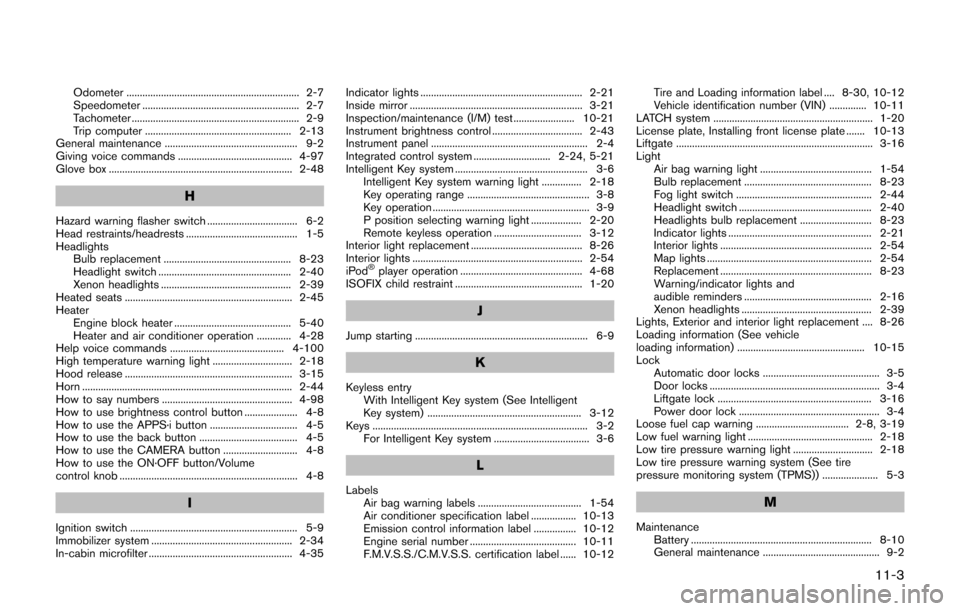
Odometer ................................................................. 2-7
Speedometer ........................................................... 2-7
Tachometer ............................................................... 2-9
Trip computer ....................................................... 2-13
General maintenance .................................................. 9-2
Giving voice commands ........................................... 4-97
Glove box ..................................................................... 2-48
H
Hazard warning flasher switch .................................. 6-2
Head restraints/headrests .......................................... 1-5
Headlights Bulb replacement ................................................ 8-23
Headlight switch .................................................. 2-40
Xenon headlights ................................................. 2-39
Heated seats ............................................................... 2-45
Heater Engine block heater ............................................ 5-40
Heater and air conditioner operation ............. 4-28
Help voice commands ........................................... 4-100
High temperature warning light .............................. 2-18
Hood release ............................................................... 3-15
Horn ............................................................................... 2-44
How to say numbers ................................................. 4-98
How to use brightness control button .................... 4-8
How to use the APPS·i button ................................. 4-5
How to use the back button ..................................... 4-5
How to use the CAMERA button ............................ 4-8
How to use the ON·OFF button/Volume
control knob ................................................................... 4-8
I
Ignition switch ............................................................... 5-9
Immobilizer system ..................................................... 2-34
In-cabin microfilter ...................................................... 4-35 Indicator lights ............................................................. 2-21
Inside mirror ................................................................. 3-21
Inspection/maintenance (I/M) test ....................... 10-21
Instrument brightness control .................................. 2-43
Instrument panel ........................................................... 2-4
Integrated control system ............................. 2-24, 5-21
Intelligent Key system .................................................. 3-6
Intelligent Key system warning light ............... 2-18
Key operating range .............................................. 3-8
Key operation ........................................................... 3-9
P position selecting warning light ................... 2-20
Remote keyless operation ................................. 3-12
Interior light replacement .......................................... 8-26
Interior lights ................................................................ 2-54
iPod
�Šplayer operation .............................................. 4-68
ISOFIX child restraint ................................................ 1-20
J
Jump starting ................................................................. 6-9
K
Keyless entry With Intelligent Key system (See Intelligent
Key system) .......................................................... 3-12
Keys ................................................................................. 3-2 For Intelligent Key system .................................... 3-6
L
LabelsAir bag warning labels ....................................... 1-54
Air conditioner specification label ................. 10-13
Emission control information label ................ 10-12
Engine serial number ........................................ 10-11
F.M.V.S.S./C.M.V.S.S. certification label ...... 10-12 Tire and Loading information label .... 8-30, 10-12
Vehicle identification number (VIN) .............. 10-11
LATCH system ............................................................ 1-20
License plate, Installing front license plate ....... 10-13
Liftgate .......................................................................... 3-16
Light Air bag warning light .......................................... 1-54
Bulb replacement ................................................ 8-23
Fog light switch ................................................... 2-44
Headlight switch .................................................. 2-40
Headlights bulb replacement ........................... 8-23
Indicator lights ...................................................... 2-21
Interior lights ......................................................... 2-54
Map lights .............................................................. 2-54
Replacement ......................................................... 8-23
Warning/indicator lights and
audible reminders ................................................ 2-16
Xenon headlights ................................................. 2-39
Lights, Exterior and interior light replacement .... 8-26
Loading information (See vehicle
loading information) ................................................ 10-15
Lock Automatic door locks ............................................ 3-5
Door locks ................................................................ 3-4
Liftgate lock .......................................................... 3-16
Power door lock ..................................................... 3-4
Loose fuel cap warning ................................... 2-8, 3-19
Low fuel warning light ............................................... 2-18
Low tire pressure warning light .............................. 2-18
Low tire pressure warning system (See tire
pressure monitoring system (TPMS)) ..................... 5-3M
Maintenance Battery .................................................................... 8-10
General maintenance ............................................ 9-2
11-3